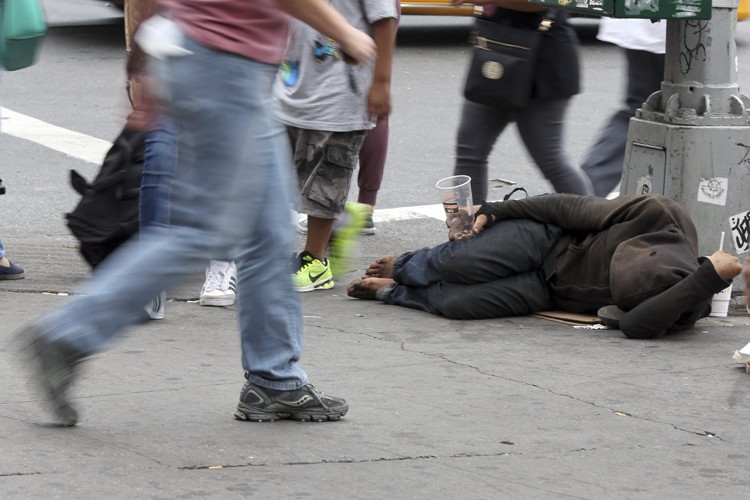ARCHIVES AP
As of June, nearly 59,000 people slept in homeless shelters in New York City, up from 42,000 in December 2011, according to the Coalition for the Homeless.
–
Posted on September 14, 2015 at 5:00 a.m.
–
–
–
At the intersection of 14th Street and Broadway in Manhattan, Marisela Pena stops in front of a grubby-faced homeless man and pulls out her cell phone. Sitting on the sidewalk, flanked by two dogs, the man in his twenties sleeps, his head resting on a backpack. At his feet, a sign calling for the generosity of passers-by (“Even a penny helps!”) Stands next to an overturned goblet.
“It breaks my heart,” said Pena, a bank worker, after taking a photo of the homeless man, whose forearms show needle marks. “He’s so young, so handsome. There are so many things he could do. ”
But why take a picture of him?
“I’ll send the photo to the mayor’s office,” replies the New Yorker in her forties. The City must do something with all these homeless people. There are so many in the streets, more than ever. ”
These days, many New Yorkers are making the same observation as Marisela Pena, even if they do not all stop to take pictures of homeless people living at the intersection of the busiest streets or begging at the gates of most frequented buildings. Last week, MSNBC morning show host Joe Scarborough and former Republican representative even used the word “epidemic” to describe the phenomenon. Following in the footsteps of former Republican New York Mayor Rudolph Giuliani, he attributed the situation to the “progressive” policies of Bill de Blasio, who is in his second year as head of the city.
What if New York City was on track to reconnect with the sad days when the homelessness crisis seemed out of hand? Even if he rejects the criticisms of Scarbouroughs, Giuliani and tutti quanti, the mayor of Blasio, one of the leading figures of the Democratic left, must today fight a perception (or a reality) likely to deprive him of a second mandate.
Disturbing figures
The data is not reassuring. As of June, nearly 59,000 people slept in homeless shelters in New York City, up from 42,000 in December 2011, according to the Coalition for the Homeless. To this number, we must add between 3,000 and 4,000 people who sleep on the streets, parks or the subway, according to New York City Police Chief William Bratton.
“This population has grown steadily over the past 15, 20 years,” Bratton said two weeks ago. However, it has reached a critical point, I think. ”
And the New York Post, fiercely critical of Bill de Blasio, worked throughout the summer to make the problem even more visible. For three days in July, the conservative tabloid notably featured photos of a homeless man on the Upper West Side, showing him urinating in the middle of Broadway or sleeping in front of a Victoria’s Secret store. . Last Sunday, the daily also opened its pages to Giuliani, who accuses de Blasio of having abandoned his approach to the homeless. An approach he had summed up a few days earlier in a radio interview: “You hunt them, and you hunt them, and you hunt them again.” Either they agree to get the treatment they need or you kick them out of town. ”
“We are not chasing people who are in crisis,” replied the mayor of Blasio a few days later, defending his program with a budget of $ 1 billion over four years to reduce the number of homeless people, including many suffer from mental health or addiction problems.
Michael, a 40-year-old musician who prefers not to mention his last name, admits to falling into this category. For the past two years, he has been sleeping outside one of the New York University buildings in Greenwich Village, preferring the streets to the city’s shelters.
“I went to shelters,” he says, begging in front of an electronics store on 14th Street. It’s full of people I don’t want to be around. They steal your things, they are violent. I feel like I’m in prison there, even though I’ve never been to prison. Ironically, I feel safer on the streets. ”
– .


